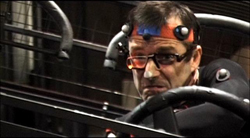the virtual world of the uncanny
In Besson’s film, real and physical sets are enhanced by the use of virtual sets and renderings, whereas more recently, the technical ability of computers to produce images is being explored more and more, and films are beginning to focus more on the virtual set, enhanced by the real set. A strong example of this is Christian Volckman’s 2006 film, Renaissance. Volckman’s film is done entirely with high contrast animation and 3D modeling. Like Scott’s film, Volckman includes elements of identifiable Paris, and remnants of familiar city fabric to convince the viewer that the action is set in Paris. These icons, like Notre Dame Cathedral, are juxtaposed with drastically new future infrastructure and architecture. The seamless quality achieved through total rendering of the set makes the entire portrayal of the city believable. It becomes difficult to decipher where the old city exists and where the ‘new’ city begins. This effect is achieved extremely successfully through this visual technique. The high contrast expression of the film is also effective in many scenes to enhance the dramatization of the scene, and therefore enhance the feelings of discomfort and uncanny generated by the film. In most cases, this sensation is generated by the action and themes of the film, but the success and credibility of the virtual set augments the uncanniness of the themes, because one can believe the action is taking place in a familiar location.
It is clear that the effect of set and design is extremely influential in the translation of psychological impression by film. While it is clear that the sensation of the uncanny can effectively be conveyed through exclusively physical sets, more recent examples of films that combine the use of physical and virtual sets exemplify the advantages of such an approach. The most convincing quality of this technique is the ability to blur the boundary between real and unreal; to make the virtual or imagined portion of the set blend perfectly with the old city. When this is achieved the previously only imaginable vision of the director is made accessible to public audiences on large. Thus, the development of set design with technology has enhanced the ability of films to successful create the ‘disquieting slippage between what seems homely and what is definitely unhomely’ that Vidler so eloquently describes.

